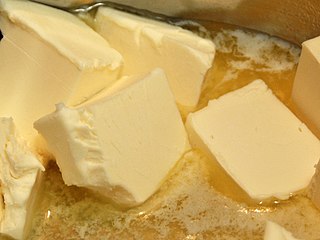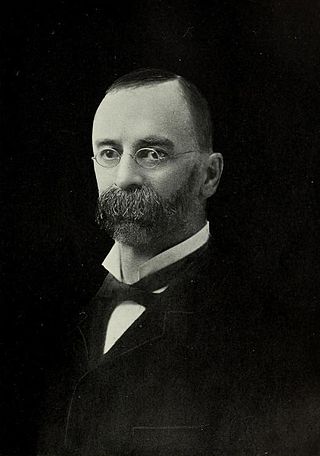Related Research Articles

Cream is a dairy product composed of the higher-fat layer skimmed from the top of milk before homogenization. In un-homogenized milk, the fat, which is less dense, eventually rises to the top. In the industrial production of cream, this process is accelerated by using centrifuges called "separators". In many countries, it is sold in several grades depending on the total butterfat content. It can be dried to a powder for shipment to distant markets, and contains high levels of saturated fat.

Butter is a dairy product made from the fat and protein components of churned cream. It is a semi-solid emulsion at room temperature, consisting of approximately 80% butterfat. It is used at room temperature as a spread, melted as a condiment, and used as a fat in baking, sauce-making, pan frying, and other cooking procedures.
A hydrometer or lactometer is an instrument used for measuring density or relative density of liquids based on the concept of buoyancy. They are typically calibrated and graduated with one or more scales such as specific gravity.

Buttermilk is a fermented dairy drink. Traditionally, it was the liquid left behind after churning butter out of cultured cream. As most modern butter in western countries is not made with cultured cream but uncultured sweet cream, most modern buttermilk in western countries is cultured separately. It is common in warm climates where unrefrigerated milk sours quickly.

Centrifugation is a mechanical process which involves the use of the centrifugal force to separate particles from a solution according to their size, shape, density, medium viscosity and rotor speed. The denser components of the mixture migrate away from the axis of the centrifuge, while the less dense components of the mixture migrate towards the axis. Chemists and biologists may increase the effective gravitational force of the test tube so that the precipitate (pellet) will travel quickly and fully to the bottom of the tube. The remaining liquid that lies above the precipitate is called a supernatant or supernate.

Gravimetric analysis describes a set of methods used in analytical chemistry for the quantitative determination of an analyte based on its mass. The principle of this type of analysis is that once an ion's mass has been determined as a unique compound, that known measurement can then be used to determine the same analyte's mass in a mixture, as long as the relative quantities of the other constituents are known.

Stephen Moulton Babcock was an American agricultural chemist. He is best known for developing the Babcock test, used to determine butterfat content in milk and cheese processing, and for the single-grain experiment that led to the development of nutritional science as a recognized discipline.

Crème fraîche is a dairy product, a soured cream containing 10–45% butterfat, with a pH of approximately 4.5. It is soured with a bacterial culture. European labeling regulations specify the two ingredients must be cream and bacterial culture. It is served over fruit and baked goods, as well as being added to soups and sauces. It is used in a variety of other recipes. Sour cream is a similar foodstuff, except that crème fraîche is less sour and has a higher fat content. Sour cream may contain thickening agents not permitted in crème fraîche in many jurisdictions.
In chemistry, a chemical test is a qualitative or quantitative procedure designed to identify, quantify, or characterise a chemical compound or chemical group.
In chemistry, acid value is a number used to quantify the acidity of a given chemical substance. It is the quantity of base, expressed as milligrams of KOH required to neutralize the acidic constituents in 1 gram of a sample.
Butterfat or milkfat is the fatty portion of milk. Milk and cream are often sold according to the amount of butterfat they contain.

The Babcock test is an inexpensive and practical procedure to determine the fat content of milk. It is named after its developer, Stephen M. Babcock (1843–1931), professor at the University of Wisconsin.

Smetana is a type of sour cream from Central, Eastern, and Southeastern Europe. It is a dairy product produced by souring heavy cream. It is similar to crème fraîche, but nowadays mainly sold with 9% to 42% milkfat content depending on the country. Its cooking properties are different from crème fraîche and the lighter sour creams sold in the US, which contain 12 to 16% butterfat. It is widely used in cooking and baking.
The Kjeldahl method or Kjeldahl digestion (Danish pronunciation: [ˈkʰelˌtɛˀl]) in analytical chemistry is a method for the quantitative determination of nitrogen contained in organic substances plus the nitrogen contained in the inorganic compounds ammonia and ammonium (NH3/NH4+). Without modification, other forms of inorganic nitrogen, for instance nitrate, are not included in this measurement. Using an empirical relation between Kjeldahl nitrogen content and protein content it is an important method for analyzing proteins. This method was developed by Johan Kjeldahl in 1883.
In chemistry, the terms volatile acid and volatile acidity (VA) are used somewhat differently in various application areas.

Clarified butter is milk fat rendered from butter to separate the milk solids and water from the butterfat. Typically, it is produced by melting butter and allowing the components to separate by density. The water evaporates, some solids float to the surface and are skimmed off, and the remainder of the milk solids (casein) sink to the bottom and are left behind when the butterfat is poured off or separated with a separatory funnel or a gravy fat separator. This butterfat is the clarified butter.

The fat content of milk is the proportion of milk, by weight, made up by butterfat. The fat content, particularly of cow's milk, is modified to make a variety of products. The fat content of milk is usually stated on the container, and the color of the label or milk bottle top varied to enable quick recognition.
Niklaus Gerber was a Swiss dairy chemist and industrialist. He was born in 1850 in Thun, Switzerland. He attended the University of Bern and University of Zurich, studied chemistry in Paris and Munich and spent 2 years at the Swiss-American Milk Co. in Little Falls, New York.

Whey cheese is a dairy product made of whey, the by-product of cheesemaking. After the production of most cheeses, about 50% of milk solids remain in the whey, including most of the lactose and lactalbumin. The production of whey cheese allows cheesemakers to use the remaining whey, instead of discarding it as a waste product.

A Babcock bottle is a clear glass flask with a long graduated neck, used in the Babcock test to evaluate the cream contents of milk. It is also called a Babcock milk test bottle, milk test bottle, cream test bottle, and other similar names.
References
- ↑ Ionel Rosenthal; Uzi Merin; Gita Popel; Solange Bernstein; Amnon Kadman (1985). "An Analytical Assay for the Determination of Oil Content in Macadamia". Agricultural Research Organization, Israel. Retrieved 4 September 2008.
Fast and accurate test methods were developed for this purpose. Two, basically similar, methods are in use: the Gerber and the Babcock methods (Atherton & Newlander. 1977). The Gerber method is the standard one in most European countries, whereas the Babcock is more common in many states of the U.S.A., although the Gerber method is also employed. Both methods are based on the digestion of all milk components, except oil, by concentrated sulfuric acid and the separation of the oil from the aqueous phase by centrifugation in special glassware, called butyrometers. In addition to fluid milk products, the Gerber test can be used for the assay of fat in cream, concentrated milk, ice cream, cheeses, and sausages (Pearson, 1970), provided that special both-ends-open butyrometers are employed. The very similar Babcock method, with various digesting reagents, has been applied satisfactorily to fish products (Horwitz, 1975).
- ↑ James, Ceirwyn S. (1994). Analytical Chemistry of Foods. Springer. pp. 50–51. ISBN 978-0-8342-1298-5 . Retrieved 28 August 2008.
Gerber method. This is a method used extensively in the UK and Europe for the routine estimation of fat in dairy products. Specific Gerber tubes, or butyrometers, have been designed for specific dairy products such as whole milk, skimmed milk, cream and cheese. Methods have been developed for these particular products and also for other dairy products, such as butter and ice cream, by using butyrometers designed for one of the above specific products and modifying the procedure for the alternative products. Thus, the fat content of butter may be measured by using cream butyrometers and that of ice cream by using whole milk or cheese butyrometers, appropriate modifications to the method being undertaken.
The procedure involves measuring a specified amount of dairy product into the butyrometer, and adding concentrated sulfuric acid (to dissolve the non-fat milk solids) and amyl alcohol to aid the separation of fat and aqueous phases. Water is added where necessary to bring the liquid levels to a point where the fat level is on the scale. The addition of the sulfuric acid causes the temperature of the mixture to increase and the fat to liquif, additional warming in a water bath is occasionally necessary to effect complete liquifying of the fat and also the solubilisation of the non-fat solids. The mixture is centrifuged in a special Gerber centrifuge for a set time at 1100 rpm, and then the tubes are placed in a water bath to standardize the samples before the fat reading is read off the calibrated scale of the butyrometer. - ↑ James, Ceirwyn S. (1994). Analytical Chemistry of Foods. Springer. pp. 50–51. ISBN 978-0-8342-1298-5 . Retrieved 28 August 2008.
Babcock method. The principle of the Babcock method is similar to that of the Gerber described above. It differs from the Gerber method in the nature of the glassware used and in the specification of dividers or calipers to measure the length of the fat column. The Babcock method is widely used in the USA.
- ↑ Badertscher, René; Thomas Berger; Rolf Kuhn (January 2007). "Densitometric determination of the fat content of milk and milk products". International Dairy Journal. Elsevier Ltd. 17 (1): 20–23. doi:10.1016/j.idairyj.2005.12.013.
The fat content of a milk product is an important indication of quality, both economically and physiologically. In the dairy industry, it is mainly determined by using quick methods. Spectrometric measuring methods are often used. However, these methods have to be calibrated, which is costly. Many laboratories, therefore, are using a method developed by the Swiss chemist and dairy-owner Niklaus Gerber, patented in 1891 under the name Acid-Butyrometrie. This method is still used because it is simple, fast, low-cost and suitable for a relatively high sample throughput. However, butyrometry has several disadvantages. The determination cannot be automated and involves a certain risk in handling highly concentrated sulphuric acid, especially while reading the butyrometer. Handling the butyrometer requires practical skills, which has a negative effect on the robustness of the method. A great disadvantage is the varying definition of fat compared with the reference methods. In the latter, fat is always defined by extraction with a non-polar solvent. In the butyrometric method, this extraction step is missing. Several attempts have been made to harmonize the fixed butyrometer scale with the values from reference analysis. Even with the costly gravimetric reference methods, attempts were made to automate or simplify the procedure.
- ↑ "Association of analytical chemists (AOAC) recommends Gerber test". Dairy Field. Stagnito Publishing. July 2002.
Research was recently published in the Journal of AOAC International, which concludes that the Gerber method be adopted as an official first action for testing butterfat in whole milk. The Gerber method is used worldwide as a simple and rapid method for determining the fat in raw and processed milk. It was first recognized in the United States in 1960 and remains an approved volumetric procedure in Standard methods for the Examination of Dairy Products. However, it had never gained status as an official method by AOAC. Additionally, the volume of the test portion has not been internationally agreed upon.